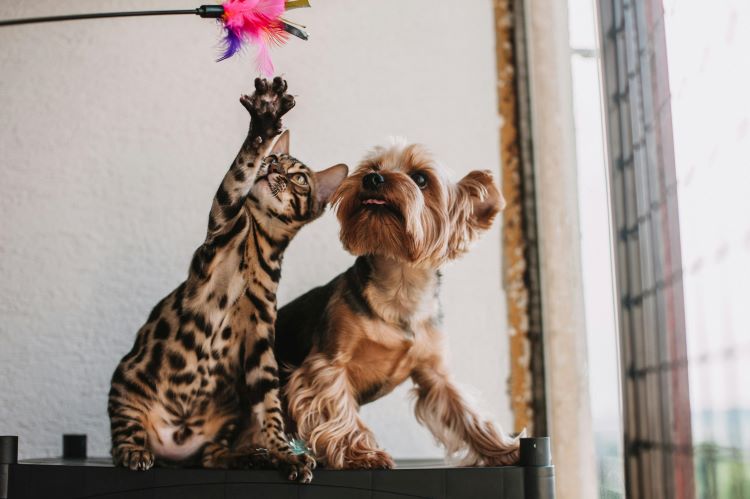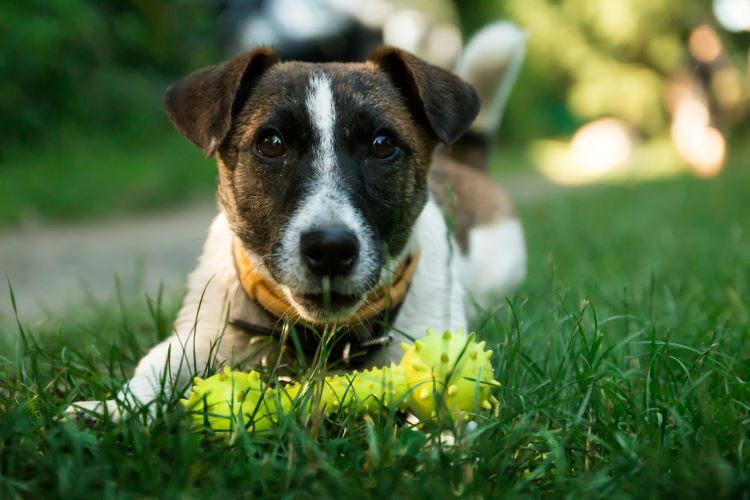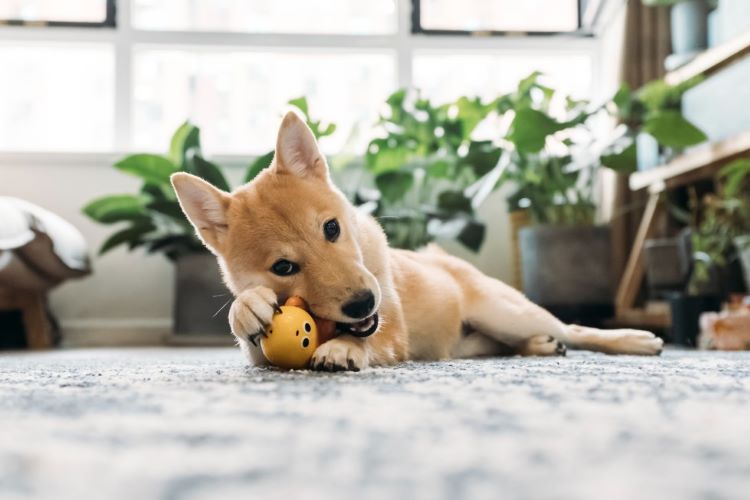Ready to help treat your pet to a healthy life?
How to Know What Toys are Safe for Dogs & Cats
By : Brianna Gunter | Published Dec 20, 2024

Pet toys promote the well-being of every dog and cat. The right toys provide pets with crucial daily stimulation, from physical exercise to mental enrichment. And when you get involved in playtime, they can also help strengthen the human-pet bond that makes your lives more fulfilling. But did you know that not all items marketed as pet toys are safe for your furry friend?
Believe it or not, some pet toys can be downright dangerous for dogs and cats. And to state the obvious: the last thing you want is for playtime to end with a trip to the emergency animal hospital. Fortunately, becoming better informed as a pet owner can help you make responsible decisions regarding your pet’s playthings. While it’s always wise to consult with your veterinarian about how to choose pet-safe toys, reading this article is a great first step!
Common pet toy dangers
In order to know how to choose safe pet toys, you’ll have to understand what the dangers are to begin with. Your pet’s particular risks will depend on their species and breed, but there are some general ones all pet owners should be aware of:
- Choking hazards — Loose, small, or broken parts can all cause blockages.
- Damage to the gastrointestinal tract— In addition to blockages, ingested toys may cut or perforate your pet’s insides and lead to a medical emergency.
- Toxic ingestion — Some toys are made with harmful ingredients or treated with chemicals that can cause harmful reactions in your pet.
- External wounds — Sharp edges or broken parts can hurt your pet in a variety of situations.
- Stress — While playtime is supposed to decrease stress, certain toys may cause overstimulation.
The good news is that pet toys are, overall, still hugely beneficial for your pal’s health and well-being. While the risks are scary, it’s just more reason to make smart decisions and choose toys that are designed with your pet’s welfare in mind.
8 tips for choosing pet-safe dog and cat toys
No pet’s life is complete without plenty of toys to play with. To prevent playtime accidents, follow these key tips for choosing safe toys for dogs and cats.

1. Know pet toys from people toys
Let’s be honest — if you have young kids as well as pets, you might easily confuse their toys from time to time. They’re both colorful! They’re plush! They’re often chewed and drooled on! But take caution; these toys serve different species for a reason. Even if a children’s plushy looks like something your dog would enjoy fetching, it may contain harmful stuffing or be made with non-durable materials.
Keep pet and children toys separate
This is a good opportunity to teach your kids responsibility with pets and take one more step in keeping your four-legged family member safe. Keep pet toys and children’s toys stored separately, and be sure to pick up any “people toys” you spot laying around on floors or where pets can easily access them. Buttons and batteries can be highly dangerous for pets who chew on them, as can a number of other common components in kid toys.
2. Consider your pet’s unique health risks
Your pet may be suffering from a chronic condition that makes chasing fast toys not just difficult, but hazardous to their health. Or they could simply be allergic to certain materials. To find out if your pal has any specific health risks and to learn more about navigating them, it’s imperative that you talk with their veterinarian. Ideally, you should do this before buying any new kind of toy.
While you’re at it, consider protecting your dog or cat with pet insurance if you have not already done so. While specific risks can vary from pet to pet, no pet owner can fully predict what accidents or surprise health conditions could come their way in the future.
3. Choose size-appropriate pet toys
Dogs and cats come in a wide range of sizes, even among their own respective breeds. A pet toy that’s a choking hazard for a large dog may be the perfect size for a smaller dog, just as a kitten may be intimidated by the size of a toy that’s ideal for a fully-grown Maine Coon. Choosing size-appropriate toys for pets is crucial to prevent choking or swallowing hazards, or even just frustration or lack of interest. Read labels carefully, and pick toys designed for your pet’s breed, age, and chewing style for safe play.
4. Avoid harmful materials
Just because something is sold as a pet toy does not mean it’s safe for dogs and cats. Take a close look at all toys you’re considering and avoid the following:
- Loosely-wound rope or any toy with strings that unravel easily
- Thin rubber that can be easily torn apart
- BPA, PVS or any other potentially harmful chemical (unsure? Just ask your vet!)
- Anything with sharp edges
- Small objects that could easily be swallowed and/or choked on
- Squeakers (squeaky toys are popular, but avoid ones with a visible or removable squeaker)
- Anything that cracks or breaks easily
- Bean bags (or any other toys with this kind of filling)
- Overly hard toys that could damage your pet’s teeth
What about rawhide?
Rawhide has long been a popular material for dog chew toys, but it’s also come under scrutiny for being unsafe. There are different kinds of rawhide, and some may be more likely to harm your pet than others. It’s always wise to check in with your veterinarian about any rawhide chew you’re considering, though you may just want to avoid them entirely to be on the safe side.
Learn more about the risks of rawhide.
5. Follow dog bone safety
While avoiding dangerous materials and questioning rawhide, it’s important to review some basic ground rules for pet bone toys and chews. These come in both natural and synthetic form, with important caveats for both. In general, veterinarians consider natural bones to be safe for dogs. But avoid cooked bones, as these are more likely to shatter and splinter when your pup chews on them.
So, what about the alternative? Synthetic bones are usually thick rubber or nylon. While safe overall (unless treated with harmful chemicals), any tiny pieces that get torn off can cause an obstruction in your pet’s digestive tract. If you go this route, inspect bone chews daily and get rid of ones getting worn out or broken.
Can cats have bone toys?
Cats are natural predators, so it may seem like giving them bones is an obvious choice. But if you have a cat at home, it’s best to just err on the side of caution and avoid giving them any bones. Firstly, there is a lot of disagreement among professionals over how safe bones are for cats. Moreover, cats too can suffer internal damage from any bones that break or splinter. Besides, while cats are naturally inclined to hunt small animals, it’s the meat that they’re really after.
6. Avoid pet toys that are too ‘busy’
Loud noises and flashing lights can be fun on children’s toys, but the same features can stress pets out. This is just another reason why it’s important to separate kid and pet toys for safety reasons. Even so, some labeled for cats and dogs may still miss the mark.
Of course, this doesn’t at all mean you should only choose pet toys that are boring. On the contrary! Bright colors with different patterns and shapes can be mentally stimulating, as can puzzle-solving features (like areas to hide treats).
7. Research toy brands
This is easier said than done, especially when you’re actively browsing the toy aisle of a pet store. Still, it’s a good idea to do a deep dive into pet toy brands you’re interested in. Doing so will help ensure the safety, durability, and even the general enjoyment of the products for your pet.
Taking some time to look into different brands will also help you identify toys tailored to your pet's needs, such as chew strength or activity level, enhancing their physical and mental stimulation. Trusted brands are also more likely to prioritize non-toxic materials and undergo testing for durability and safety.
8. Stock up on different kinds of toys
While you’re shopping for pet toys, be sure to get a few different kinds. Stocking up on a variety of toys keeps your pet engaged, mentally stimulated, and physically active. Different toys cater to various needs:
- Chew toys for dental health
- Puzzle toys for mental challenges
- Fetch/teaser toys for exercise
Rotating toys prevents boredom and destructive behavior, while offering options that suit your pet's changing mood or activity level. If you have multiple pets, having an array of toys to choose from is even more important. This will help reduce competition and aggression over toys, promoting a playful, stress-free atmosphere for all.

More quick tips for pet toy safety
Choosing pet-safe toys is only the beginning. As time goes on and the toys become used, there are some easy things you can do to keep playtime safe and fun.
It’s always a good idea to keep an eye on your pet during play sessions, even if the toy in question doesn’t seem all that dangerous. For example, ribbon and yarn are popular toys for cats, but they still pose a choking risk if swallowed. You’ll also want to regularly clean toys to prevent grime and bacteria from threatening your pet’s health. If you notice any damage — particularly loose strings or jagged edges — throw the affected toy away instead of giving it back to your pet.
Even with the best precautions in place though, you can’t always predict what will come your pet’s way. To help protect your pet’s health against accidents and other unwelcome surprises, learn how pet insurance works.
